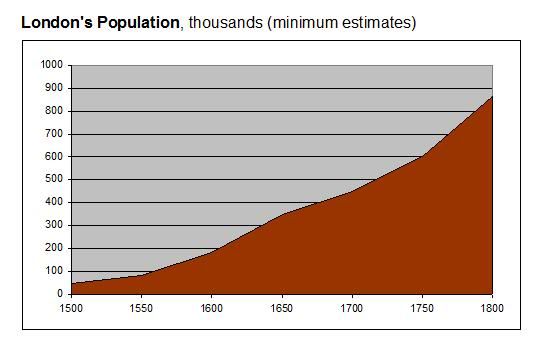The paper gives some indication of the shares of some of the non-agricultural activities which by 1600 must have occupied something around half a million countryfolk, twice the urban labour force. But instead of pursuing this promising line of enquiry the authors go on to conjure up an estimate of per capita income based on agricultural employment shares and GDP in developing countries in 2007. England around 1600 had, we are told, a per capita income similar to Uzbekistan today, solely on the basis of a similar share occupied in agriculture - this from the scholar who (with considerable justification) condemned Angus Maddison's projections as "fictions... based not on empirical evidence, but on unsubstantiated and demonstrably implausible theories of the nature of life in pre-industrial societies". It's unclear quite what the Uzbekistan of 2007 is meant to tell us about pre-industrial England, except that most of its inhabitants by 1560 lived far above subsistence levels, which is hardly news. It's a promising paper, sadly derailed by its lead author's over-keenness to demonstrate the absence of significant per capita income growth before the Industrial Revolution.
Much the same goes for Clark's other new paper, on employment shares and income in the England of 1381. This time there's some of the occupational detail missing for the later period (like the author I was quite taken by the finding that 2.5% of those occupied in the sampled parishes were engaged in brewing) - and there's a real surprise, in the conclusion that only 55% of the labour force worked in agriculture (62% if all those returned as "labourers" and the like are assigned to farming), far lower than the 75% widely assumed to have been so occupied. The sample size is small - fewer than 3% of rural parishes and only two boroughs - and may over-represent smaller (non-borough) country towns at the expense of more strictly rural districts. But it's a thought-provoking illustration of the extent of late medieval rural crafts and commerce.
There's little evidence though for Clark's assertion on the basis of erratic wage and price data that English income per capita in 1381 averaged 94% of the 1817 level: again we're asked to put our faith in "modern data on income and farm shares across poorer countries" extrapolated according to a formula which yields an income elasticity of food demand "consistent with cross-sectional evidence for England in 1862" (at the end of what Greg and his then co-authors once aptly termed the "British food puzzle" of rising incomes and sluggish food demand in the Industrial Revolution period).
Taken together, these two papers offer a valuable insight into the English occupational history being researched elsewhere under Shaw-Taylor and Wrigley. It's frustrating that rather than use their occupational data to reconstruct the dimensions of real economic activity, the authors instead veer off into a mechanistic equation of occupational shares (and only one occupation at that) with GDP. Hopefully there'll be more detailed and nuanced investigation to follow.
